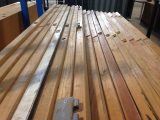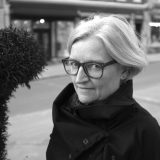 Free webinar on October 16, 12pm – 1:30pm EDT. Three speakers will consider how heritage and conservation can address the issue of waste in building materials, with reference to dynamic heritage values, principles of the Circular Economy, and practices of deconstruction for reuse.
Free webinar on October 16, 12pm – 1:30pm EDT. Three speakers will consider how heritage and conservation can address the issue of waste in building materials, with reference to dynamic heritage values, principles of the Circular Economy, and practices of deconstruction for reuse.
Speakers:
- Building Conservation and the Circular Economy, Satu Huuhka, Senior Research Fellow/Adjunct Professor in the School of Architecture, Tampere University, Finland;
- Waste and New Heritage Values, Susan Ross, OAQ, FAPT, Associate Professor, Carleton University, Canada
- Deconstructing Heritage, Tina McCarthy, MDS, Preservation Planner, Town of Brookline, Massachusetts, USA
- Dr. Ona Vileikis, editor of the Journal of Cultural Heritage Management and Sustainable Development, will make an announcement about the special issue on Heritage and Waste
Moderators: Victoria Angel and Zeynep Ekim, ERA Architects, Canada.
Presented by: NSERC CREATE Heritage Engineering program; Carleton University School of Indigenous and Canadian Studies; Tampere University; ERA Architects Inc.; Emerald Publishing; ICOMOS Canada; and APT Ottawa Valley-Outaouais Chapter.
CLICK HERE FOR EVENT POSTER: Webinar Poster 2020Oct.4
Emerald Publishing has very kindly agreed to provide Free Access to the Special Issue: Heritage and Waste Values in the Journal of Cultural Heritage Management and Sustainable Development following the webinar on October 16.
For more information, contact: Susan.ross@carleton.ca ..
Satu Huuhka, Building Conservation and the Circular Economy:
 Satu Huuhka is Architect (MSc) and DSc in Architecture. She currently holds the position of Senior Research Fellow/Adjunct Professor in the School of Architecture, Tampere University (Finland), where she has also taught Architectural Construction and Renovation. Her 2016 dissertation focused on obsolete parts of the building stock as an underestimated reserve for spatial and material resources. Her present research interests include conservation, renovation and adaptive reuse of spaces, reuse and recycling of construction components and materials, as well as any architecture theoretical and conservation theoretical considerations relating to the aforementioned topics. satu.huuhka@tuni.fi
Satu Huuhka is Architect (MSc) and DSc in Architecture. She currently holds the position of Senior Research Fellow/Adjunct Professor in the School of Architecture, Tampere University (Finland), where she has also taught Architectural Construction and Renovation. Her 2016 dissertation focused on obsolete parts of the building stock as an underestimated reserve for spatial and material resources. Her present research interests include conservation, renovation and adaptive reuse of spaces, reuse and recycling of construction components and materials, as well as any architecture theoretical and conservation theoretical considerations relating to the aforementioned topics. satu.huuhka@tuni.fi
This presentation will discuss the relation between building conservation and circular economy (CE), which are often erroneously seen as inherently contradictory to one another. The work is based on a comparative approach, drawing from theories of architectural conservation as well as those of CE to discuss their mutual relation. It is found that both architectural conservation and CE aim at safeguarding value, although they define ‘value’ differently. Fabric-focused conservation and CE favor minimal intervention to material, albeit they arrive at this conclusion from different bases. CE could be harnessed for building conservation by adopting its vocabulary and methodology, such as life cycle assessment and material flow analysis. Respectively, building conservation professionals would have a lot of expertise to contribute to the practical implementation of CE. Transitioning towards CE can help increase the preservation of built heritage while redefining what is meant by ‘heritage’ and ‘waste’.
Susan Ross, Waste and New Heritage Values
 Susan M. Ross is a licensed architect and Associate Professor, Carleton University, cross appointed to the Schools of Indigenous and Canadian Studies/Architecture and Urbanism. Susan organized the 2018 symposium “Heritage in Reverse: Material Values, Waste and Deconstruction, co-edited the special issue on “Heritage and Waste” of the Journal of Cultural Heritage Management and Sustainable Development, and edits Waste Heritage Research. Susan has over twenty years professional experience in Montreal, Ottawa and Berlin, in private sector, not for profit and government work. Her teaching and research focus is the sustainable conservation of modern and industrial heritage – from materials to historic urban landscapes. susan.ross@carleton.ca.
Susan M. Ross is a licensed architect and Associate Professor, Carleton University, cross appointed to the Schools of Indigenous and Canadian Studies/Architecture and Urbanism. Susan organized the 2018 symposium “Heritage in Reverse: Material Values, Waste and Deconstruction, co-edited the special issue on “Heritage and Waste” of the Journal of Cultural Heritage Management and Sustainable Development, and edits Waste Heritage Research. Susan has over twenty years professional experience in Montreal, Ottawa and Berlin, in private sector, not for profit and government work. Her teaching and research focus is the sustainable conservation of modern and industrial heritage – from materials to historic urban landscapes. susan.ross@carleton.ca.
The concept of waste can be defined as the absence of value. Values-based conservation processes, which assign heritage value and select limited elements to be protected, can therefore arguably contribute to creating waste. Recognition of the complexity of heritage values, including negative physical values (e.g. toxicity) or dissonant associated values, helps to make space for needed new perspectives. Thinking about values and waste across a mutable spectrum can challenge conservation’s narrow focus on intact buildings and sites, which traditionally limits materials salvage to highly valued elements for future restoration purposes, treatment as spolia, or artefact collection. In addition to conserving the embodied effects of all materials, processes of materials reclamation, deconstruction and reuse can not only sustain, but generate new values. As the vast materials legacy of the 20th century becomes the focus of stewardship, understanding of how to transfer values in components and not just whole buildings becomes crucial. Accelerating contexts of demolition and disaster add urgency for heritage practitioners to engage in critical discussion of multiple material destinies.
Tina McCarthy, Deconstructing Heritage
 Tina M. McCarthy is Preservation Planner for the Town of Brookline, Massachusetts, and co-owns a general contracting firm specializing in sustainable building and materials reuse. She earned an M.D.S. in Historic Preservation from Boston Architectural College in 2018 and a B.A. in Native American Studies from Hampshire College in 2004. Her thesis was entitled “Deconstructing the culture of demolition: Exploring deconstruction as a strategy for historic preservation.” She has presented at Building Materials Reuse Association and Association for Preservation Technology Conferences as well as the “Heritage in Reverse” symposium at Carleton University. tmccarthy575@gmail.com.
Tina M. McCarthy is Preservation Planner for the Town of Brookline, Massachusetts, and co-owns a general contracting firm specializing in sustainable building and materials reuse. She earned an M.D.S. in Historic Preservation from Boston Architectural College in 2018 and a B.A. in Native American Studies from Hampshire College in 2004. Her thesis was entitled “Deconstructing the culture of demolition: Exploring deconstruction as a strategy for historic preservation.” She has presented at Building Materials Reuse Association and Association for Preservation Technology Conferences as well as the “Heritage in Reverse” symposium at Carleton University. tmccarthy575@gmail.com.
A gap exists in heritage practice within the USA, as defined by the US Secretary of Interior’s Standards, which offer no treatment for a building entering the end of its lifecycle. In this space, unsalvageable historic structures and vernacular buildings that fall outside the narrow criteria for landmark designation remain vulnerable to demolition despite preservation efforts. A global emerging alternative to demolition, whole building deconstruction, challenges the assumption that the end of a building’s lifecycle must result in total loss. Through a case study of the non-profit Emergent Structures in Savannah, Georgia, this talk will illuminate the potential contribution of heritage values to the practices of the deconstruction industry. This example will offer a glimpse into a world where heritage values and conservation operate in the space formerly dominated by demolition, destruction and waste. By engaging the ethic of reuse as a wholistic system that supports sustainability goals, heritage professionals can participate in a positive alternative to demolition and the culture of disposal.
Victoria Angel, Moderator
 Victoria Angel is an Associate and the Cultural Heritage Lead at ERA Architects Inc., where she develops heritage conservation strategies plans for historic places and urban areas. Her recent projects have included the Senate of Canada Building rehabilitation, the National Arts Centre Rejuvenation, and the Booth Street Complex Redevelopment. She previously worked for Parks Canada, where she led the development of the Canadian Register of Historic Places and subsequently served as the Manager of the Federal Heritage Buildings Review Office. She is adjunct professor at Carleton University. Together with Susan Ross, she co-edited the special issue on “Heritage and Waste” of the Journal of Cultural Heritage Management and Sustainable Development. VictoriaA@eraarch.ca
Victoria Angel is an Associate and the Cultural Heritage Lead at ERA Architects Inc., where she develops heritage conservation strategies plans for historic places and urban areas. Her recent projects have included the Senate of Canada Building rehabilitation, the National Arts Centre Rejuvenation, and the Booth Street Complex Redevelopment. She previously worked for Parks Canada, where she led the development of the Canadian Register of Historic Places and subsequently served as the Manager of the Federal Heritage Buildings Review Office. She is adjunct professor at Carleton University. Together with Susan Ross, she co-edited the special issue on “Heritage and Waste” of the Journal of Cultural Heritage Management and Sustainable Development. VictoriaA@eraarch.ca